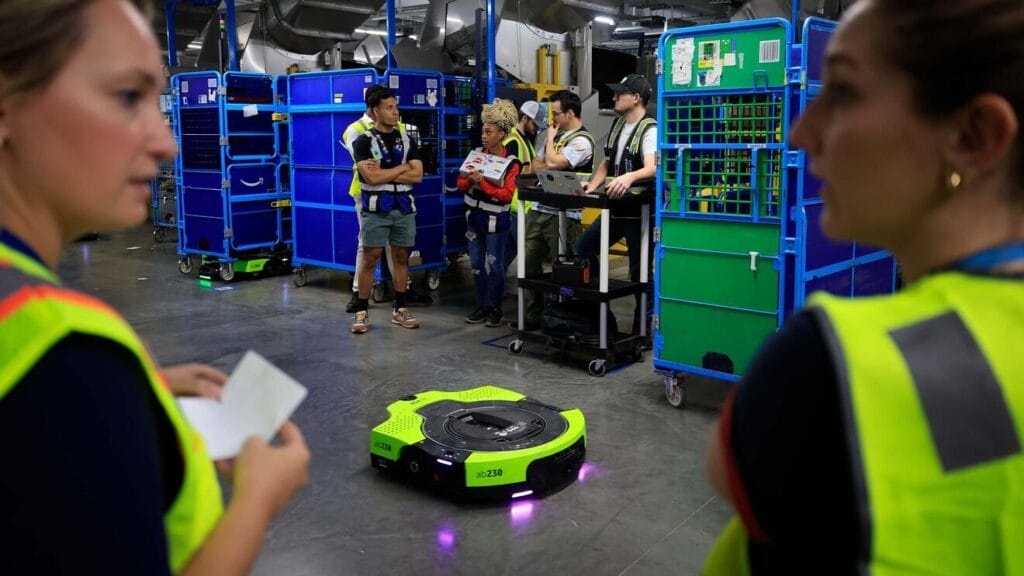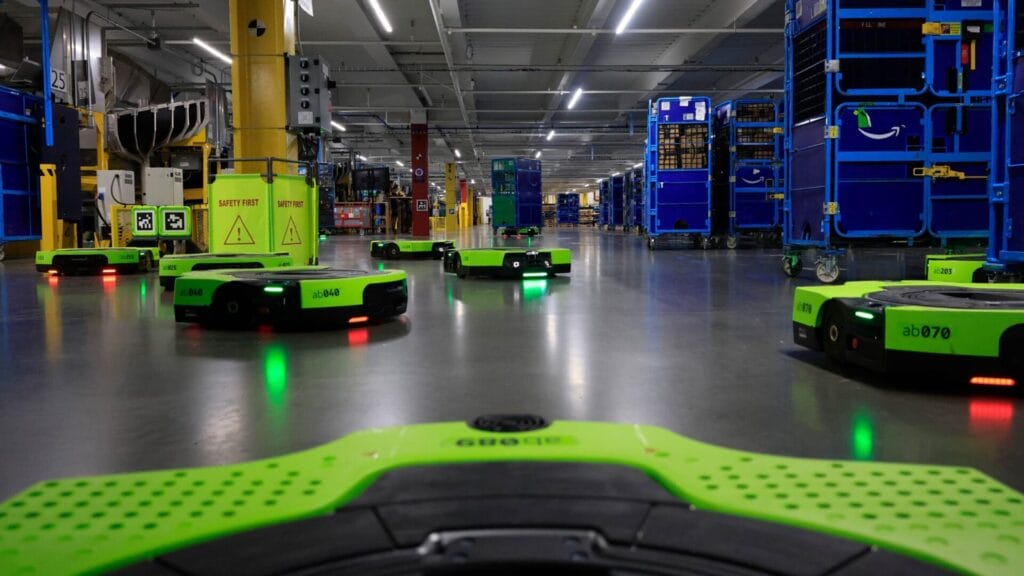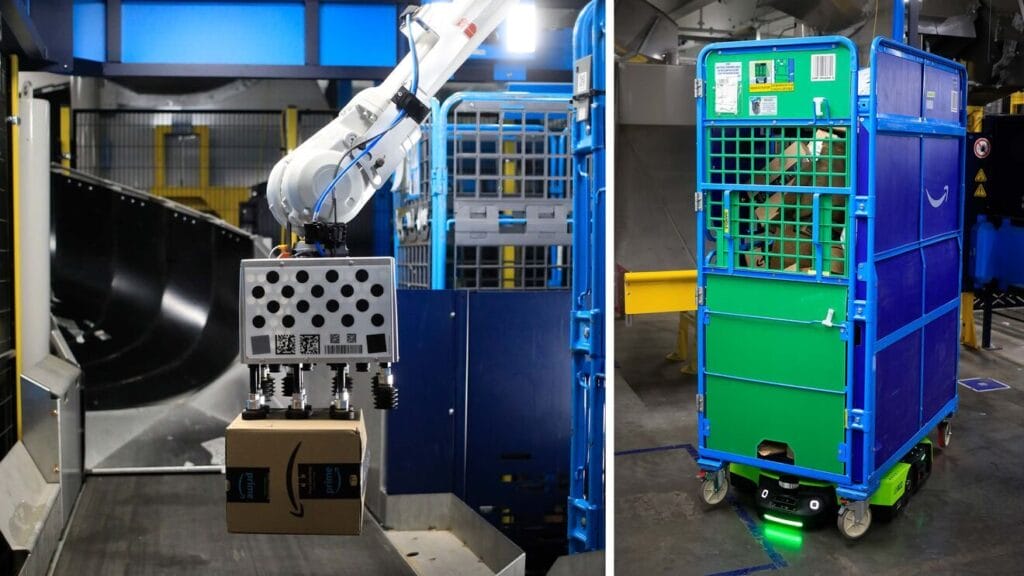In a blog post published on October 11th, the company announced the launch of a fleet of friendly robots individually called “Proteus.” Proteus bots look similar to some autonomous vacuums, and were designed with a jovial personality in mind that can fully interact with other robots in the facility and human staff.

Amazon wrote its post from the perspective of Proteus, explaining its capabilities and what role the bots play. The company wrote (excerpts):
My name is Proteus and I’m one of the hardworking robots here at Amazon. This may be the first time we’re officially meeting, but we may have already crossed paths in some way. I move packages at our fulfillment centers so that they get placed in trucks that take the packages to the next step in the fulfillment process. And one of those trucks may have been carrying a package that eventually made its way to you. Is it fate that we meet, you say? I’d call it by another name: good ol’ Amazon innovation.
So what makes me so unique? I’m Amazon’s first autonomous mobile robot. Which is a fancy way of saying, I’ve got the smarts and technology that allow me to work independently and safely around people. This means that I can navigate freely within my work area in our fulfillment centers and detect and avoid objects around me, allowing me to safely work outside the fenced areas where many of my robotic co-workers must stay.
Amazon’s fulfillment centers are filled with all sorts of busy robots (you’ve probably already met some of them, like Cardinal and Sparrow—they gesticulate a lot).
So what exactly do I do? I lift and move large, wheeled carts in the outbound area of a fulfillment center. Each cart is filled with packages that are ready to ship out. Some of these carts can weigh up to 800 pounds.

With me in the picture, my co-workers no longer have to do the heavy lifting. This means there’s less chance of stress and injury, which translates to better productivity and health for employees, while also introducing opportunities for employees to take on new roles working with robots like me. It also means packages can move faster through our warehouses, and get to you even sooner.
On a typical workday, I handle two shifts of about 10 hours each. After my buddy Cardinal stacks packages onto a rolling cart, I scoot on over, position myself under the cart, lift it, and carry it to the next step in our fulfillment process. Then, I head back to Cardinal to grab the next cart.

Through special technology developed by Amazon that uses Simultaneous Localization and Mapping, or SLAM. It’s a virtual map of my environment, and, like a GPS, my sensors tell me where I am with respect to that map. I’m then free to choose my own path.
Everything is managed by a computerized warehouse management system that orchestrates what everyone in the building is doing, from the people to the robots. That’s how I get my marching orders, so I know when, say, a truck is arriving and I need to bring a cart to it.
As independent as I am, none of my work would be possible without the help of my human colleagues. There are whole teams of people whose jobs ensure that I can do my job well. For instance, “floor monitors” keep the area around me clear, and they check for objects lying around or any liquid spills that could become a hazard to both people and robots. There’s also a maintenance engineering team that keeps me in tip-top shape. They handle everything from mechanical and repair issues, to cleaning my lenses, to managing the software that makes me operate.
One of the cool things about my job is that it actually helps create even more jobs for people to work with me. Amazon’s got a program called Career Choice, which provides training to employees who, among other careers, want to work as maintenance engineers for our robots. So, as our robot fleet grows, so does the need for skilled people […] to work with us.
AUTHOR COMMENTARY
Amazon, like all other companies that are flooding their warehouses and offices with robots and artificial intelligence algorithms, keep trying to downplay that this is not going to replace workers but actually increase staff members. Well, perhaps initially to those with the degree and experience to do repair and maintenance, but this will not be most people, especially young people, who have had little time or opportunity to get the necessary education and training to do tech repair and maintenance, and climb in rank in these companies.
SEE: Amazon To Test Humanoid Robot In Fulfillment Center, As Company Already Deploys 750,000 Other Robots
Coding Is Dead: More Than A Quarter Of New Code At Google Was Written By AI
So, let’s cut the crap and tell it the way that it is: AI and robotics are replacing traditional work. I still believe and encourage people to get involved in trades and other similar skills so that you are less dependent on these companies and the government, but there is no question the jobs market is in disarray and a lot of people will be out of jobs within the next few years as AI and robotics replace the average worker and those lower on the totem pole.
And all of this at its core is to buttress people’s ever-increasing impatience, convenience, and instant gratification; and companies are using this to keep trimming the fat and make more money in the process.
1 Timothy 6:10 For the love of money is the root of all evil: which while some coveted after, they have erred from the faith, and pierced themselves through with many sorrows.
[7] Who goeth a warfare any time at his own charges? who planteth a vineyard, and eateth not of the fruit thereof? or who feedeth a flock, and eateth not of the milk of the flock? [8] Say I these things as a man? or saith not the law the same also? [9] For it is written in the law of Moses, Thou shalt not muzzle the mouth of the ox that treadeth out the corn. Doth God take care for oxen? [10] Or saith he it altogether for our sakes? For our sakes, no doubt, this is written: that he that ploweth should plow in hope; and that he that thresheth in hope should be partaker of his hope. (1 Corinthians 9:7-10).
The WinePress needs your support! If God has laid it on your heart to want to contribute, please prayerfully consider donating to this ministry. If you cannot gift a monetary donation, then please donate your fervent prayers to keep this ministry going! Thank you and may God bless you.








Young people need to learn to work with their hands, rip stuff apart and put it back together, learn skilled trades, welding, plumbing, auto repair, all things that require a skill of hands and not computer junk, like digging a ditch. With these skills you will go far.
By all means do not go to collage, it will destroy your future, you’ll be in debt and won’t be able to get a job with your fake title or degree, it’s useless.